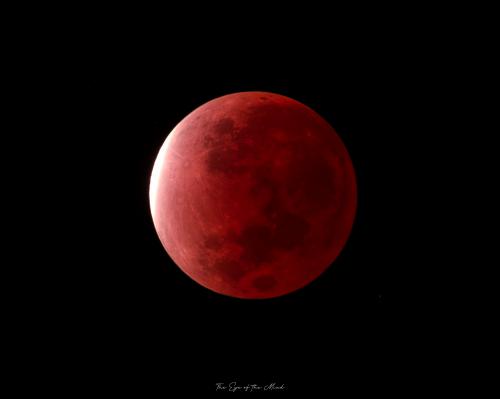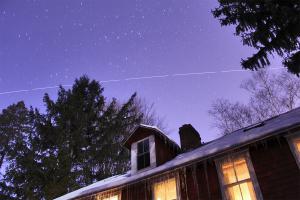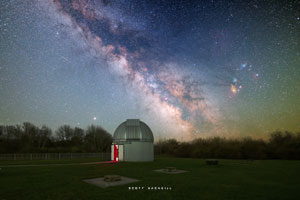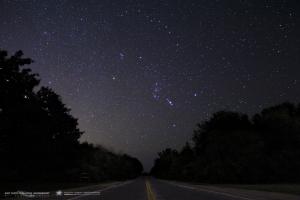Celebration of Space - November 19, 2021

The almost-total lunar eclipse on November 19, 2021 by Frosty Drew Astronomy Team member, James Crouch.
Now that the new PlaneWave CDK600 24 inch telescope is operational, we are ready to point it to the sky and see what the cosmos has to offer. Over the remainder of November and the first half of December, we will be hosting our First Light Celebration, which will give our visitors a chance to look through what is now the largest telescope in the state that is open for public observation. Our First Light Celebration will bring additional viewing nights, and will also give local astro geeks a chance to learn about the new CDK design and direct drive mechanism, as well as what our plans are for this telescope. We will post frequent updates to our events calendar as well as to our Facebook and Twitter (@FrostyDrewOBSY) regarding these events. We also have a running photo gallery of the PlaneWave telescope, which is always being updated. Check it out. Now make plans to stop in and see the rings of Saturn, the storms of Jupiter, and the wisps of the Orion Nebula through the largest aperture and most advanced telescope in the state.
This morning’s full Moon was the full lunar phase for November, and is called the Full Beaver Moon.
Which originates from Native American and early settler significance. During November is when beavers begin to shelter for the winter months. Early trappers would hunt beavers during November for their fur, which was thick for the coming winter. Another name for the November Moon is the Full Frosty Moon, which I like better. November is often the month of frosty mornings, a true harbinger that the end of Autumn is upon us. Even though the full Moon occurred early this morning, tonight’s Moon will still appear quite full. So step outside and offer a belated welcome to the Full Beaver / Frosty Moon and start thinking about the festive celebrations that are just around the corner.
Over the past week the International Space Station (ISS) has returned to the evening sky over our region. Due to the ISS orbiting Earth inclined 51° to the equator, it places the ISS over our region at progressively different times every day. But to see the Station, it needs to be in direct sunlight while an observer on Earth is under night. The result is that we see the ISS passing over our region either during the morning hours before sunrise, the evening hours after sunset, both, or not at all. The months around the Summer Solstice will bring the most passes per nighttime period due to the Northern Hemisphere being tilted 23.4° towards the Sun. Passes are still visible around the Winter Solstice, but usually only one or two per night. Here are a few notable passes for this weekend and coming week:
Sat, Nov 20 at 5:55 pm in the WSW, rising to 79°, heading towards the NE and into orbital sunset. ← Awesome Pass
Sun, Nov 21 at 5:08 pm in the SW, rising to 61°, heading towards the ENE and into orbital sunset ← Awesome Pass
Mon, Nov 22 at 5:58 pm in the W, rising to 33°, and into orbital sunset
Tue, Nov 23 at 5:10 pm in the WSW, rising to 48°, heading towards the NE and into orbital sunset
These times are specific for Southern New England, and applicable for the entire Northeast. Evening passes will continue over our region until December 12, 2021, giving us numerous opportunities to be inspired. For daily pass times of the ISS and other bright satellites, visit the Frosty Drew Observatory Daily Satellite Pass Prediction utility. Set your alarm, put on your jacket, and enjoy a moment with humanity’s only continuously inhabited space-based residence.
Now that we are on the tail end of autumn, many of the stunning summertime constellations are quickly departing the night sky. Though because sunset times progressively get earlier with each passing day, these constellations appear to linger a bit, which is the opposite of springtime, when the constellations appear to advance very quickly due to the progressive loss of night to the summer Sun. Because of this the Summer Triangle asterism, which is made up of five constellations (Lyra, Cygnus, Aquila, Sagitta, and Vulpecula), is visible well through autumn. Even though the summer constellations linger in the early evening hours, the wintertime constellations are still advancing as usual, and we are starting to see Orion rise in the east a few hours after sunset.
Orion is probably one of the most recognized constellations in the night sky and is loaded with many fabulous celestial sights. For those early risers, who are up before the Sun rises in the morning, you have probably noticed that super bright star in the southern sky. That is Sirius, which is the brightest star in Earth’s nighttime sky, and is home to the closest white dwarf to the Solar System.
Now that the Moon is past full and starting to depart the night sky, you can start catching views of the wintertime Milky Way from dark locations, like Frosty Drew. The wintertime view that the Earth has of the Milky Way is the opposite view that we have during the summer season. This is because during the Northern Hemisphere winter, the nighttime side of Earth faces the outer edge of the Milky Way, instead of towards the center as we see in the summer. The Perseus Arm is what we see during winter and is much dimmer. Some of the best wintertime objects sit along this region. Objects like the Messier 46 open star cluster, the Rosette Nebula, the Wolf-Rayet Star – Thor's Helmet, the Auriga clusters, and more.
Over the next few weeks as the Moon departs, try to take notice of the constellations in the western sky during twilight, then step out again around 8:00 pm and look to the east. This is the time of the year when you can get a good view of both summer and wintertime constellations.
Have a Happy Thanksgiving from all the astro-geeks at Frosty Drew Observatory!
- Author:
- Scott MacNeill
- Entry Date:
- Nov 19, 2021
- Published Under:
- Scott MacNeill's Columns




